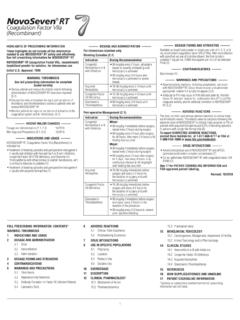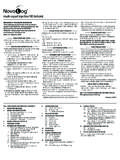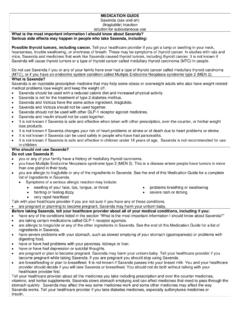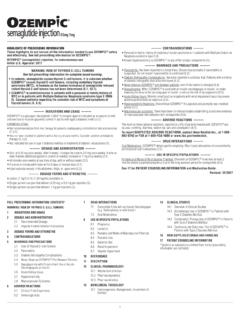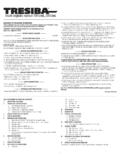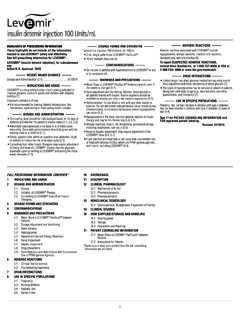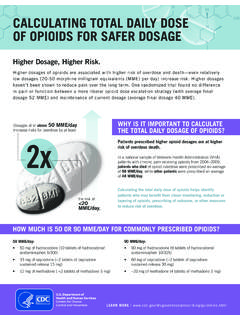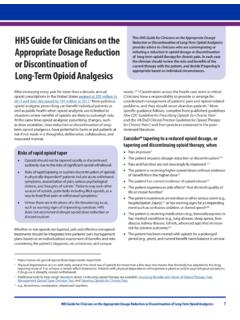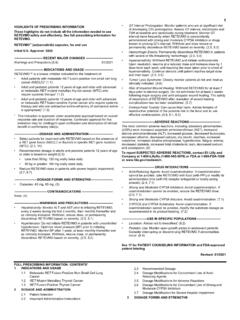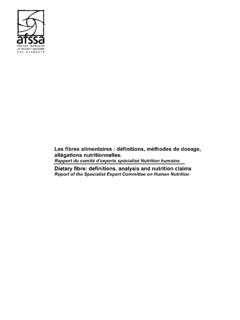Transcription of DOSAGE FORMS AND STRENGTHS ——— RYBELSUS ...
1 1 See the Full Prescribing Information for instructions on switching between OZEMPIC and RYBELSUS ( ). DOSAGE FORMS AND STRENGTHS Tablets: 3 mg, 7 mg and 14 mg (3). CONTRAINDICATIONS Personal or family history of medullary thyroid carcinoma or in patients with Multiple Endocrine Neoplasia syndrome type 2 (4). Prior serious hypersensitivity reaction to semaglutide or any of the excipients in RYBELSUS (4). WARNINGS AND PRECAUTIONS Pancreatitis: Has been reported in clinical trials. Discontinue promptly if pancreatitis is suspected. Do not restart if pancreatitis is confirmed ( ). Diabetic Retinopathy Complications: Has been reported in a cardiovascular outcomes trial with semaglutide injection.
2 Patients with a history of diabetic retinopathy should be monitored ( ). Hypoglycemia: Concomitant use with an insulin secretagogue or insulin may increase the risk of hypoglycemia, including severe hypoglycemia. Reducing dose of insulin secretagogue or insulin may be necessary ( ). Acute Kidney Injury: Monitor renal function in patients with renal impairment reporting severe adverse gastrointestinal reactions ( ). Hypersensitivity Reactions: Serious hypersensitivity reactions ( , anaphylaxis and angioedema) have been reported. Discontinue RYBELSUS if suspected and promptly seek medical advice ( ). ADVERSE REACTIONS The most common adverse reactions, reported in 5% of patients treated with RYBELSUS are: nausea, abdominal pain, diarrhea, decreased appetite, vomiting and constipation ( ).
3 To report SUSPECTED ADVERSE REACTIONS, contact Novo Nordisk Inc., at 1-833-457-7455 or FDA at 1-800-FDA-1088 or DRUG INTERACTIONS Oral Medications: RYBELSUS delays gastric emptying. When coadministering oral medications instruct patients to closely follow RYBELSUS administration instructions. Consider increased clinical or laboratory monitoring for medications that have a narrow therapeutic index or that require clinical monitoring ( ). USE IN SPECIFIC POPULATIONS Pregnancy: May cause fetal harm ( ). Lactation: Breastfeeding not recommended ( ). Females and Males of Reproductive Potential: Discontinue RYBELSUS in women at least 2 months before a planned pregnancy due to the long washout period for semaglutide ( ).
4 See 17 for PATIENT COUNSELING INFORMATION and Medication Guide. Revised: 04/2021 FULL PRESCRIBING INFORMATION: CONTENTS*WARNING: RISK OF THYROID C CELL TUMORS1 INDICATIONS AND USAGE2 DOSAGE AND ADMINISTRATION Important Administration Instructions Recommended DOSAGE Switching Patients between OZEMPIC and RYBELSUS 3 DOSAGE FORMS AND STRENGTHS4 CONTRAINDICATIONS5 WARNINGS AND PRECAUTIONS Risk of Thyroid C-Cell Tumors Pancreatitis Diabetic Retinopathy Complications Hypoglycemia with Concomitant Use of Insulin Secretagogues or Insulin Acute Kidney Injury Hypersensitivity6 ADVERSE REACTIONS Clinical Trials Experience Immunogenicity Postmarketing Experience7 DRUG INTERACTIONS Concomitant Use with an Insulin Secretagogue (.)
5 Sulfonylurea) or with Insulin Oral Medications8 USE IN SPECIFIC POPULATIONS Pregnancy Lactation Females and Males of Reproductive Potential Pediatric Use Geriatric Use Renal Impairment Hepatic Impairment10 OVERDOSAGE11 DESCRIPTION12 CLINICAL PHARMACOLOGY Mechanism of Action Pharmacodynamics Pharmacokinetics13 NONCLINICAL TOXICOLOGY Carcinogenesis, Mutagenesis, Impairment of Fertility Animal Toxicology and/or Pharmacology14 CLINICAL STUDIES Overview of Clinical Studies Monotherapy Use of RYBELSUS in Patients with Type 2 Diabetes Mellitus Combination Therapy Use of RYBELSUS in Patients with Type 2 Diabetes Mellitus Cardiovascular Outcomes Trial in Patients with Type 2 Diabetes Mellitus and Cardiovascular Disease16 HOW SUPPLIED/STORAGE AND HANDLING17 PATIENT COUNSELING INFORMATION*Sections or subsections omitted from the full prescribing information are not OF PRESCRIBING INFORMATIONT hese highlights do not include all the information needed to use RYBELSUS safely and effectively.
6 See full prescribing information for RYBELSUS . RYBELSUS (semaglutide) tablets, for oral use Initial Approval: 2017 WARNING: RISK OF THYROID C CELL TUMORSSee full prescribing information for complete boxed warning. In rodents, semaglutide causes thyroid C-cell tumors. It is unknown whether RYBELSUS causes thyroid C-cell tumors, including medullary thyroid carcinoma (MTC), in humans as the human relevance of semaglutide-induced rodent thyroid C-cell tumors has not been determined ( , ). RYBELSUS is contraindicated in patients with a personal or family history of MTC or in patients with Multiple Endocrine Neoplasia syndrome type 2 (MEN 2). Counsel patients regarding the potential risk of MTC and symptoms of thyroid tumors (4, ).
7 RECENT MAJOR CHANGES Contraindications (4)..04/2021 Warning and Precautions, Hypoglycemia with Concomitant Use of Insulin Secretagogues or Insulin ( ) ..04/2021 Warning and Precautions, Hypersensitivity ( )..04/2021 INDICATIONS AND USAGE RYBELSUS is a glucagon-like peptide-1 (GLP-1) receptor agonist indicated as an adjunct to diet and exercise to improve glycemic control in adults with type 2 diabetes mellitus (1).Limitations of Use Not recommended as first-line therapy for patients inadequately controlled on diet and exercise (1, ). Has not been studied in patients with a history of pancreatitis (1, ). Not for treatment of type 1 diabetes mellitus (1).
8 DOSAGE AND ADMINISTRATION Instruct patients to take RYBELSUS at least 30 minutes before the first food, beverage, or other oral medications of the day with no more than 4 ounces of plain water only. Waiting less than 30 minutes, or taking with food, beverages (other than plain water) or other oral medications will lessen the effect of RYBELSUS . Waiting more than 30 minutes to eat may increase the absorption of RYBELSUS (2 .1). Swallow tablets whole. Do not cut, crush, or chew tablets ( ). Start RYBELSUS with 3 mg once daily for 30 days. After 30 days on the 3 mg dose, increase the dose to 7 mg once daily ( ). Dose may be increased to 14 mg once daily if additional glycemic control is needed after at least 30 days on the 7 mg dose ( ).
9 RYBELSUS (semaglutide) tablets, for oral use2 FULL PRESCRIBING INFORMATIONWARNING: RISK OF THYROID C CELL TUMORS In rodents, semaglutide causes dose-dependent and treatment-duration-dependent thyroid C-cell tumors at clinically relevant exposures. It is unknown whether RYBELSUS causes thyroid C-cell tumors, including medullary thyroid carcinoma (MTC), in humans as human relevance of semaglutide-induced rodent thyroid C-cell tumors has not been determined [see Warnings and Precautions ( ) and Nonclinical Toxicology ( )]. RYBELSUS is contraindicated in patients with a personal or family history of MTC or in patients with Multiple Endocrine Neoplasia syndrome type 2 (MEN 2) [see Contraindications (4)].
10 Counsel patients regarding the potential risk for MTC with the use of RYBELSUS and inform them of symptoms of thyroid tumors ( a mass in the neck, dysphagia, dyspnea, persistent hoarseness). Routine monitoring of serum calcitonin or using thyroid ultrasound is of uncertain value for early detection of MTC in patients treated with RYBELSUS [see Contraindications (4) and Warnings and Precautions ( )]. 1 INDICATIONS AND USAGERYBELSUS is indicated as an adjunct to diet and exercise to improve glycemic control in adults with type 2 diabetes mellitus [see Clinical Studies ( )].Limitations of Use RYBELSUS is not recommended as a first-line therapy for patients who have inadequate glycemic control on diet and exercise because of the uncertain relevance of rodent C-cell tumor findings to humans [see Warnings and Precautions ( )].
